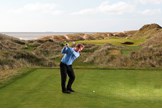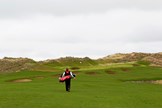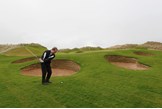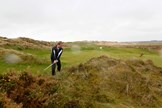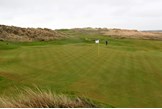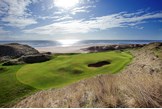EXCLUSIVE: First play of Trump Scotland
Published: Last updated:
The first divot. The first chip and run. The first thinned bunker shot and the first putt. At Trump International Links, Golf World was responsible for them all.
Partly due to “The Donald’s” ability to create headlines, partly down to the special piece of land on which the course is built, the level of expectation has been enormous. And whether it is a film, a footballer or a golf course, with that huge expectation comes a very real possibility of disappointment. But as we walked off the course, disappointment was not our primary emotion. This is a special new links, the like of which we may not witness again for half a century – possibly ever – in Britain.
Not many developers have this kind of capital to pump into a project. Fewer still are inclined to sink it into 18 holes. And perhaps rarest of all is the land on which Trump International is built; he examined over 100 sites – including an Irish property he was close to buying – before he set his heart on the Balmedie dunes. And all that has contributed to the course being the highest entry in Golf World’s new Top 100 ranking.
Designed by the R&A’s preferred architect, Martin Hawtree, it is spectacular without being overtly showy, unremittingly exacting without being grossly unfair. It is stunning in both bright sunshine and driving rain (we experienced both). It is breathtaking and intimidating, classy and sensational. We are confident such descriptions are closer to caution than hyperbole.
Only the biggest dunes were used; it’s not a course which knowingly undersells itself. Its brilliance is immediately obvious, and then relentlessly hole after hole. Most follow the valley floor between huge sand hills unique in Scotland. In my experience only sections of Ballybunion and Carne are comparative. But here you get the sheer size of dune more consistently.
Some designers may have been tempted to route some holes on the less dynamic, flatter land to add variety – not least in terms of direction, because only the 13th is west to east rather than heading north or south within the site’s fairly narrow strip of linksland. But when the owner announces he is “building the greatest golf course in the world”, one imagines it is difficult to resist using anything other than the most dramatic topography.
There are no obviously weak holes. The 11th may be the weakest, but this is merely relative. Links Superintendent John Bambury could see it becoming one of the best. The Dubliner guided us round like a proud parent showing us his children’s paintings. He admits he has to get it right here; he has the product, now he must add the gloss. Asked if north-east Scotland’s climate makes it harder to condition a course as exquisitely as, say, a southern England heathland, he instantly rejects the suggestion. It is difficult to imagine this will not always be a magnificently manicured layout. Certainly, the bent-fescue greens which extend out to the fringes are already a delight to putt on.
It is proper links fare which purists will salivate over. There are also none of the wicked slopes which can so enrage people; Hawtree has employed gentle ripples rather than steep contours. While the dunes and greens are gloriously linksy, there are fewer views of the sea than one expected. It peeps at you regularly – notably on the 3rd green – but the height and density of the dunes mean this is not a Turnberry-like experience, the water lapping the shore as you tee off.
Laid out in two sections, the front nine to the south of the clubhouse and the back nine to the north, it was the protected latter section – a wetland housing many species of birds – which required patience to allow work to begin. It was easy to see why Trump and Hawtree were so keen to use it.
The course begins with a fairly gentle par 5 along the coastal dune ridge. It initially daunts, but on closer inspection you content yourself, quite correctly, it is more forgiving. On the 2nd, the North Sea is glimpsed for the first time while the first short hole, the 3rd, is a classic. Five different tees give it so much variety in.
The 4th (above) will be a much admired and much photographed par 5 whose fairway ripples away from you with dunes on the left, the burn on the right and bunkers decorating the greenfront. A raised green rejects anything but fine approaches. This is the most southerly point and will be a brute played into the prevailing wind, which is not off the North Sea, as we experienced, but rather from the south west.
You now turn and play a short-ish par 4. Even off the backs it is just 386 yards and off the ‘Medal’ tees it is 350. With the prevailing wind at their tail, long hitters will fancy blasting over the sea of heather off the elevated tee to leave themselves little more than a chip and run. But cute short par 4s always have plenty of evil defences – here heather, rough and pot bunkers set punishing traps. It is followed by Hawtree’s favourite, the par-3 6th among a sea of dunes, then an even shorter two shotter – the 281-yard 7th. These shorter par 4s, and the vast teeing options, give variety to the otherwise relentlessly robust links.
The 13 to 15 stretch is the back nine’s highlight. It begins with a par 3 of 229 yards which plays across the property towards the sea. From an elevated tee you hit into a sloping green guarded by four pots. Here in particular required hand planting of thousands of marram grasses. These stabilise the mobile dune structures and this process came at astonishing cost. You march off the back of the green and between two dunes to one of Britain’s most spectacular holes.
That tiny corridor between the sand hills is the door to the Secret Garden; rolled out in front of you from your elevated position is a fairway lined by gargantuan sand hills. It is the best of Waterville and Ballybunion in one hole. Then comes another fine, shortish two shotter – 323 yards off the Medal – which takes you to the links’ furthest point north. A par 3 into the prevailing wind is followed at 17 by a par 4 which was apparently the subject of most debate between Trump and Hawtree. The latter won and the former is now said to rate the hole among his favourites.
From there you board one of six tees on the last, where your focus will be on the 18 bunkers – nearly a quarter of the course’s total of 85. At 651 yards off the back tees, this is a brutish par 5 with the wind into.
It is the links’ exacting nature where caution must be struck. Choose the wrong tees and severe punishment will follow; the fairways are relatively tight and lined with dense rough. With winds often strong, it could be a miserable experience for higher handicappers who select wrongly.
Visitors are welcome – and the fee of £150, in comparison with other big-name courses, is modest – but the course has been built to test the elite. The Ryder Cup has been mooted as early as 2022. The Open has been whispered. Certainly, both events go to lesser venues. His course will be prepared; even if a hotel doesn’t happen (due to wind farms), a swish clubhouse and discreet infrastructure are in place (though not buggy paths because it will, happily, be a walking-only links). So, too, are miles of underground pipes, waiting for TV cables to be fed through.
Trump International awaits the world. We suspect the world will be impressed.
Click here for an exclusive interview with Donald Trump.

